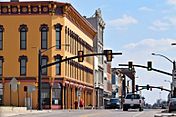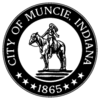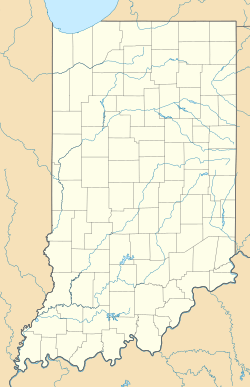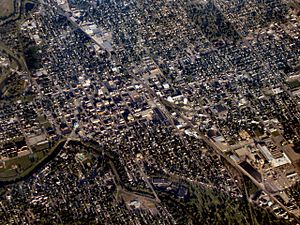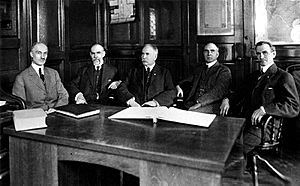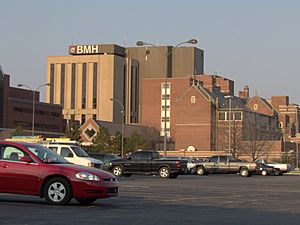Muncie, Indiana facts for kids
Quick facts for kids
Muncie
|
|||||
|---|---|---|---|---|---|
|
Clockwise from top: Walnut Street Historic District, Appeal to the Great Spirit, Minnetrista Museum & Gardens, Ball State University
|
|||||
|
|||||
| Nickname(s):
Middletown
|
|||||
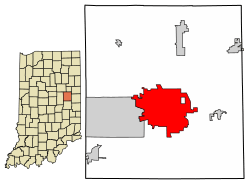
Location of Muncie in Delaware County, Indiana
|
|||||
| Country | United States | ||||
| State | Indiana | ||||
| County | Delaware | ||||
| Townships | Center, Hamilton, Harrison, Liberty, Mount Pleasant | ||||
| Founded | 1827 | ||||
| Incorporated (town) | December 6, 1854 | ||||
| Incorporated (city) | 1865 | ||||
| Government | |||||
| • Type | Mayor-Council | ||||
| Area | |||||
| • City | 27.60 sq mi (71.49 km2) | ||||
| • Land | 27.40 sq mi (70.98 km2) | ||||
| • Water | 0.20 sq mi (0.51 km2) | ||||
| Elevation | 935 ft (285 m) | ||||
| Population
(2020)
|
|||||
| • City | 65,194 | ||||
| • Density | 2,379.00/sq mi (918.54/km2) | ||||
| • Metro | 111,903 | ||||
| • Demonym | Munsonian | ||||
| Time zone | UTC−5 (EST) | ||||
| • Summer (DST) | UTC−4 (EDT) | ||||
| ZIP Codes |
47302–47308
|
||||
| Area code | 765 | ||||
| FIPS code | 18-51876 | ||||
| GNIS feature ID | 2395138 | ||||
| Interstate highways |
|
||||
| U.S. Highways |
|
||||
| Major state roads |
|
||||
| Waterways | West Fork of White River | ||||
| Airports | Delaware County Regional Airport | ||||
| Public transit | MITS | ||||
Muncie (/ˈmʌnsi/ MUN-see) is a city in Delaware County, Indiana, United States. It's the main city of the Muncie metropolitan statistical area. Muncie is about 50 miles (80 km) northeast of Indianapolis.
In 2020, about 65,195 people lived there. The city is famous for being home to Ball State University. It's also known as "Middletown" because of special studies done there since the 1920s. These studies looked at how people lived in a typical American city.
Contents
Exploring Muncie's Past
Early Days and Name Origins
The area where Muncie is now was first settled in the 1790s. The Lenape people, also called the Delaware, moved here from the eastern United States. They built villages along the White River, including one called Munsee Town.
The name "Munsee Town" comes from the "Munsee" group of the Lenape people. It's a common story that a chief named Munsee existed, but there's no proof of that. The name simply refers to the Lenape clan.
In 1818, the native tribes gave up their land to the U.S. government. They agreed to move further west by 1821. New settlers started arriving around 1820. The small trading village, then called Muncietown, became the main town for Delaware County in 1827. In 1845, its name was officially shortened to Muncie.
Growth and Industry in Muncie
Muncie became a town in 1854 and a city in 1865. John Brady was the first mayor. Early services like waterworks started in the mid-1860s.
After the American Civil War, Muncie grew a lot. More railroads arrived, making it easier to transport goods. A big discovery of natural gas in 1886 also helped. This started the Indiana gas boom. Before this, Muncie was mostly a farming area.
The gas boom brought many new businesses and people to Muncie. One important company was the Ball Brothers Glass Manufacturing Company. They built a glass factory in Muncie in 1888. This company later became the Ball Corporation. They also moved their metal manufacturing here.
Besides glass, Muncie attracted iron and steel factories. These included Kitselman Steel & Wire Company, which was once Indiana's largest employer. Even after the natural gas supply went down around 1910, Muncie remained a strong industrial city. New car manufacturing businesses also came after 1900.
Community and Education
As Muncie grew, new public buildings were built. These included a city hall, a public library, and a high school. The Muncie Star newspaper started in 1899. A new public library, funded by Andrew Carnegie, opened in 1904.
Ball State University started from a school that opened in 1899. After some struggles, the Ball brothers bought the school property. They donated it to the state of Indiana. This led to the Indiana State Normal School, Eastern Division, opening in 1918. It was later renamed Ball State University in 1965.
Muncie also developed a lively arts community. Artists like J. Ottis Adams and William Forsyth started an art school here. Many art and social clubs were formed.
By the early 1900s, several railroads connected Muncie to other cities. An electric train system, called an interurban, also linked Muncie to places like Indianapolis and Dayton, Ohio.
During World War I, Muncie's factories made supplies for the war. In the 1920s, Muncie became a center for making cars and car parts. However, during this time, there was also a lot of activity from the Ku Klux Klan. Their actions caused problems and divided the community. Their popularity decreased by the end of the decade.
During the Great Depression, the Ball brothers continued to help the community. They donated money for new buildings at Ball State and Ball Memorial Hospital. The government's Works Progress Administration (WPA) also created jobs for people.
Middletown Studies: A City Under the Microscope
In the 1920s, researchers Robert and Helen Lynd studied Muncie. They wanted to understand a typical American city. They called it "Middletown" in their books. Their first book, Middletown: A Study in Contemporary American Culture (1929), made Muncie famous. They returned during the Great Depression for a second study.
Many other studies have been done in Muncie since then. The National Science Foundation funded more research. Today, the Ball State Center for Middletown Studies still looks at how Muncie changes. Because of all these studies, Muncie is one of the most studied cities of its size in the United States.
Besides "Middletown," Muncie is also known as "Magic City" or "Magic Muncie," and the "Friendly City."
From World War II to Today
During World War II, Muncie's factories again helped with war production. Ball State and the local airport trained pilots. After the war, Muncie grew even more. New homes, schools, and businesses were built.
Since the 1950s, Muncie has become a center for education and healthcare. Ball State University and Ball Memorial Hospital both expanded. However, many factories started to close or move away in the 1970s. For example, Ball Corporation closed its Muncie glass factories in 1962.
In 2017, the Muncie Community Schools system faced challenges. The state government took control to help improve it. In 2018, Ball State's Board of Trustees helped reform the school district.
More recently, in 2021, Afghan refugees began to settle in Muncie. A group called the Muncie Afghan Refugee Resettlement Committee (MARRC) helped them. Now, a new group, Refugee Alliance of Delaware County (RADC), continues to help refugees build new lives in Muncie.
African-American History in Muncie
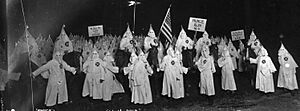
The number of black residents in Muncie grew over time. In 1890, about 3.7% of the population was black, rising to 13.2% by 2013. Some neighborhoods had rules that made it difficult for black people to be out after dark.
Muncie hired its first black police officer in 1899. The first black police chief started in 1995. The first black teacher was hired in 1952, and the first black principal in 1956.
Important black leaders in Muncie's politics include Ray Armstrong, who was the first black city council member in 1951. Alice McIntosh was the first black female city council member in 1983. Hurley Goodall was the first black person elected to the school board and later to the state house.
Muncie's Location and Weather
Muncie covers about 27.392 square miles (70.94 km2). Most of this area is land, with a small amount of water.
Muncie's Climate
Muncie has four clear seasons: spring, summer, autumn, and winter. The weather changes a lot throughout the year.
| Climate data for Muncie, Indiana (Delaware County Airport), 1991–2020 normals, extremes 1962–present | |||||||||||||
|---|---|---|---|---|---|---|---|---|---|---|---|---|---|
| Month | Jan | Feb | Mar | Apr | May | Jun | Jul | Aug | Sep | Oct | Nov | Dec | Year |
| Record high °F (°C) | 67 (19) |
77 (25) |
84 (29) |
88 (31) |
98 (37) |
106 (41) |
101 (38) |
99 (37) |
96 (36) |
93 (34) |
81 (27) |
71 (22) |
106 (41) |
| Mean maximum °F (°C) | 57.5 (14.2) |
61.6 (16.4) |
71.7 (22.1) |
81.0 (27.2) |
88.2 (31.2) |
92.6 (33.7) |
93.2 (34.0) |
91.8 (33.2) |
90.0 (32.2) |
83.4 (28.6) |
69.8 (21.0) |
60.2 (15.7) |
94.7 (34.8) |
| Mean daily maximum °F (°C) | 36.0 (2.2) |
39.9 (4.4) |
50.9 (10.5) |
64.1 (17.8) |
74.6 (23.7) |
83.0 (28.3) |
85.8 (29.9) |
84.1 (28.9) |
78.8 (26.0) |
66.3 (19.1) |
52.3 (11.3) |
40.7 (4.8) |
63.0 (17.2) |
| Daily mean °F (°C) | 28.6 (−1.9) |
31.9 (−0.1) |
41.7 (5.4) |
53.5 (11.9) |
64.4 (18.0) |
73.3 (22.9) |
76.0 (24.4) |
73.7 (23.2) |
67.2 (19.6) |
55.8 (13.2) |
43.9 (6.6) |
33.8 (1.0) |
53.6 (12.0) |
| Mean daily minimum °F (°C) | 21.3 (−5.9) |
23.9 (−4.5) |
32.5 (0.3) |
43.0 (6.1) |
54.2 (12.3) |
63.6 (17.6) |
66.3 (19.1) |
63.4 (17.4) |
55.7 (13.2) |
45.4 (7.4) |
35.6 (2.0) |
26.9 (−2.8) |
44.3 (6.8) |
| Mean minimum °F (°C) | −2.7 (−19.3) |
2.1 (−16.6) |
12.5 (−10.8) |
24.7 (−4.1) |
36.3 (2.4) |
47.2 (8.4) |
51.9 (11.1) |
49.5 (9.7) |
39.6 (4.2) |
28.2 (−2.1) |
18.4 (−7.6) |
6.2 (−14.3) |
−5.9 (−21.1) |
| Record low °F (°C) | −29 (−34) |
−13 (−25) |
−7 (−22) |
10 (−12) |
25 (−4) |
36 (2) |
44 (7) |
39 (4) |
27 (−3) |
18 (−8) |
3 (−16) |
−21 (−29) |
−29 (−34) |
| Average precipitation inches (mm) | 2.52 (64) |
2.27 (58) |
3.08 (78) |
3.89 (99) |
4.36 (111) |
4.81 (122) |
4.10 (104) |
3.38 (86) |
3.09 (78) |
2.96 (75) |
3.23 (82) |
2.57 (65) |
40.26 (1,023) |
| Average snowfall inches (cm) | 8.0 (20) |
6.4 (16) |
3.2 (8.1) |
0.4 (1.0) |
0.0 (0.0) |
0.0 (0.0) |
0.0 (0.0) |
0.0 (0.0) |
0.0 (0.0) |
0.3 (0.76) |
0.7 (1.8) |
6.4 (16) |
25.4 (65) |
| Average precipitation days (≥ 0.01 in) | 9.8 | 9.8 | 11.5 | 12.3 | 13.4 | 12.7 | 10.8 | 10.4 | 9.9 | 10.2 | 10.1 | 11.5 | 132.4 |
| Average snowy days (≥ 0.1 in) | 5.0 | 4.4 | 2.2 | 0.4 | 0.0 | 0.0 | 0.0 | 0.0 | 0.0 | 0.1 | 1.0 | 5.3 | 18.4 |
| Source: NOAA (snow 1981–2010) | |||||||||||||
Who Lives in Muncie?
| Historical population | |||
|---|---|---|---|
| Census | Pop. | %± | |
| 1850 | 666 | — | |
| 1860 | 1,782 | 167.6% | |
| 1870 | 2,992 | 67.9% | |
| 1880 | 5,219 | 74.4% | |
| 1890 | 11,345 | 117.4% | |
| 1900 | 20,942 | 84.6% | |
| 1910 | 24,005 | 14.6% | |
| 1920 | 36,524 | 52.2% | |
| 1930 | 46,548 | 27.4% | |
| 1940 | 49,720 | 6.8% | |
| 1950 | 58,479 | 17.6% | |
| 1960 | 68,603 | 17.3% | |
| 1970 | 69,082 | 0.7% | |
| 1980 | 76,460 | 10.7% | |
| 1990 | 71,035 | −7.1% | |
| 2000 | 67,430 | −5.1% | |
| 2010 | 70,085 | 3.9% | |
| 2020 | 65,194 | −7.0% | |
| 2022 (est.) | 65,076 | −7.1% | |
| U.S. Decennial Census | |||
In 2020, Muncie had 65,194 people living in 26,692 households. The city's population density was about 2,577.0 inhabitants per square mile (995.0/km2).
Most residents (78.0%) were White, and 11.6% were African American. About 4.2% of the population was Hispanic or Latino.
The average age in Muncie was 28.8 years old. Many residents (16.2%) were under 18. A large number (83.8%) were 18 or older.
The most common language spoken at home was English (95.5%). About 2.6% of the population was born outside the U.S.
The average household income in Muncie was $34,602. About 30.2% of the people lived in poverty.
Muncie's Economy: From Factories to Future
Muncie started as a trading center for farmers. Then, the Indiana gas boom in the 1880s brought many factories. This made Muncie an industrial city. Over time, Ball State University and Ball Memorial Hospital also made Muncie a center for education and healthcare.
Major industries in Muncie included glass, iron, steel, and car parts. The Ball Corporation was one of the first big companies. Other important factories included BorgWarner and General Motors.
However, like many cities in the Rust Belt, Muncie saw factories close or move away starting in the 1960s. This meant many jobs were lost. Muncie has been changing from a city with many factory jobs to one with more jobs in healthcare, education, and retail.
Muncie is attracting some new businesses. For example, Brevini Wind, an Italian company, opened its U.S. headquarters here in 2009. Progress Rail, which makes train parts, opened a factory in 2011.
There are different opinions about Muncie's economy. Some older residents miss the factory jobs. Newer residents see the city's future in education and health services. The city is working to keep college graduates in Muncie.
Muncie has been recognized for its affordability. In 2007, it was named the most affordable college town in America. In 2015, Forbes ranked Muncie highly for business and careers. First Merchants Corporation, a bank, is based in Muncie.
Here are some of the largest employers in Muncie as of July 2022:
- Ball State University (3,379 employees)
- IU Health Ball Memorial Hospital (2,613 employees)
- Muncie Community Schools (650 employees)
- Navient (633 employees)
- Magna Powertrain (571 employees)
- Concentrix (555 employees)
- First Merchants Corporation (551 employees)
- Meridian Health Services (550 employees)
- Youth Opportunity Center (516 employees)
- Progress Rail (500 employees)
Arts and Culture in Muncie
Muncie has a lively arts and culture scene.
Museums and Galleries
- The David Owsley Museum of Art at Ball State University has over 11,000 art pieces.
- The Horizon Convention Center downtown has space for exhibits. It also houses the Muncie Children's Museum.
- Muncie has many independent art galleries.
- Minnetrista Museum & Gardens is a cultural museum along the White River. It has exhibits about nature, local history, and art. The 40-acre (16-hectare) campus includes historic homes, gardens, and sculptures.
Performing Arts and Music
- Ball State University has three large performing arts centers:
- Emens Auditorium (3,581 seats)
- Sursa Performance Hall (600 seats)
- University Theatre (410 seats)
- Downtown Muncie has the Muncie Civic Theatre and Canan Commons, an outdoor stage.
- The Muncie Ballet and the Muncie Symphony Orchestra are also important parts of the city's arts community.
- Muncie has been home to several music bands.
Outdoor Spaces
- The Cardinal Greenway is Indiana's longest rail trail. It's 60 miles (97 km) long and is part of the American Discovery Trail.
- Christy Woods at Ball State is an 18-acre (7.3-hectare) arboretum with greenhouses and an orchid collection.
Public Art
- You can find sculptures like Passing of the Buffalo and Appeal to the Great Spirit in Muncie.
Libraries in Muncie

Muncie has several libraries:
- Carnegie Library
- Kennedy Library
- Maring–Hunt Library
- Connection Corner
- Shafer Library (Ivy Tech)
- Bracken Library (Ball State)
Sports in Muncie
Muncie is home to the NCAA Division I Ball State Cardinals sports teams. They are part of the Mid-American Conference.
- Football games are played at Scheumann Stadium.
- Men's basketball games are played at John E. Worthen Arena.
- Baseball games are played at Ball Diamond.
Muncie also had professional sports teams in the past:
- The Muncie Flyers (also known as the Congerville Flyers) were a professional football team from 1905 to 1925. They were one of the first teams in the National Football League (NFL).
- The Muncie Flyers were a minor league hockey team in 1948–1949.
Muncie Central High School has the Muncie Fieldhouse, one of the largest high school gyms in the United States.
Education in Muncie
Muncie offers many educational opportunities, from elementary schools to universities.
School Districts
- Muncie Community Schools Corporation serves about 5,141 students (2022).
Higher Education
- Ball State University has about 24,441 students (2022).
- Ivy Tech Community College has about 12,400 students (2021).
- Scuba Educators International
Elementary Schools
- Burris Laboratory School
- Cowan Elementary School
- East Washington Academy
- Grissom Memorial Elementary School
- Heritage Hall Christian School
- Inspire Academy
- Longfellow Elementary School
- North View Elementary School
- Royerton Elementary School
- South View Elementary School
- St. Lawrence Catholic School
- West View Elementary School
Middle Schools
- Burris Laboratory School
- Heritage Hall Christian School
- Delta Middle School
- Northside Middle School
- Pope John Paul II Middle School
- Southside Middle School
High Schools
- Burris Laboratory School
- Heritage Hall Christian School
- Cowan High School
- Delta High School
- Indiana Academy for Science, Mathematics, and Humanities
- Muncie Area Career Center
- Muncie Central High School
Media in Muncie
Newspapers
- The Star Press is Muncie's local newspaper.
Television
Muncie is part of the Indianapolis TV market. It receives channels from Indianapolis. Muncie is also home to WIPB, the local PBS channel. The famous show The Joy of Painting was filmed at WIPB.
Radio Stations
- WCRD
- WERK
- WMXQ
- WLBC-FM
- WMUN
- WNAP-FM
- WBST
- WXXC
Getting Around Muncie
Transportation Options
Air Travel
- Delaware County Regional Airport is for general aviation, not commercial flights.
- The closest commercial airports are Fort Wayne International Airport (74.4 miles (119.7 km) away) and Indianapolis International Airport (75.4 miles (121.3 km) away).
Highways
Major roads that go through or near Muncie include:
Rail Service
Muncie used to have passenger train service until 1986 at the Wysor Street Depot. Freight trains still serve the city, provided by CSX and Norfolk Southern.
Public Transit
The Muncie Indiana Transit System (MITS) offers 14 bus routes every day except Sundays.
Famous People from Muncie
Note: This list does not include Ball State University graduates. Please see List of Ball State University alumni for notable alumni.
Arts and Public Life
- Jolly Blackburn, cartoonist (creator of Knights of the Dinner Table)
- Ray Boltz, Christian music artist
- Ball Brothers, founders of Ball Corporation
- Angelin Chang, Grammy Award-winning classical pianist
- Jim Davis, cartoonist (creator of Garfield)
- Emily Kimbrough, author and magazine editor
- Gregory H. Williams, lawyer and university president
Sports Stars
- Ron Bonham, basketball player (played for Boston Celtics)
- Dave Duerson, football player (played for Chicago Bears)
- Hod Eller, baseball player (won 1919 World Series with Cincinnati Reds)
- Ryan Kerrigan, professional football player
- Adam Lind, professional baseball player
- Matt Painter, Purdue University men's basketball head coach
- Bonzi Wells, basketball player (played for Houston Rockets, Portland Trail Blazers)
Muncie's Sister Cities
Muncie has five sister cities around the world:
 Changhua, Taiwan
Changhua, Taiwan Deyang, China
Deyang, China Isparta, Turkey
Isparta, Turkey Taraz, Kazakhstan
Taraz, Kazakhstan Zhuji, China
Zhuji, China
See also
 In Spanish: Muncie (Indiana) para niños
In Spanish: Muncie (Indiana) para niños


